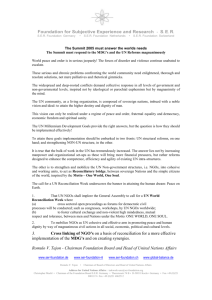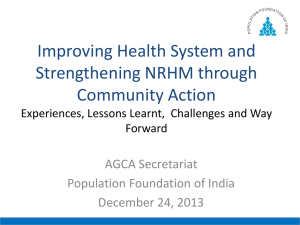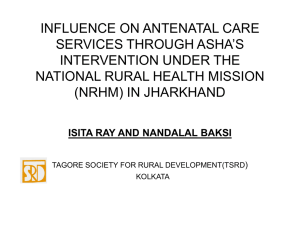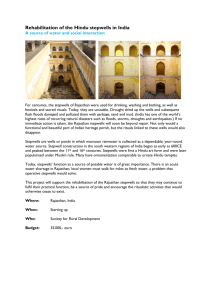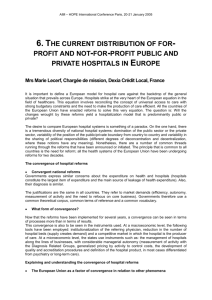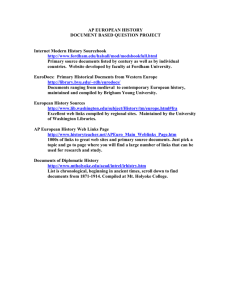Background - National Rural Health Mission
advertisement
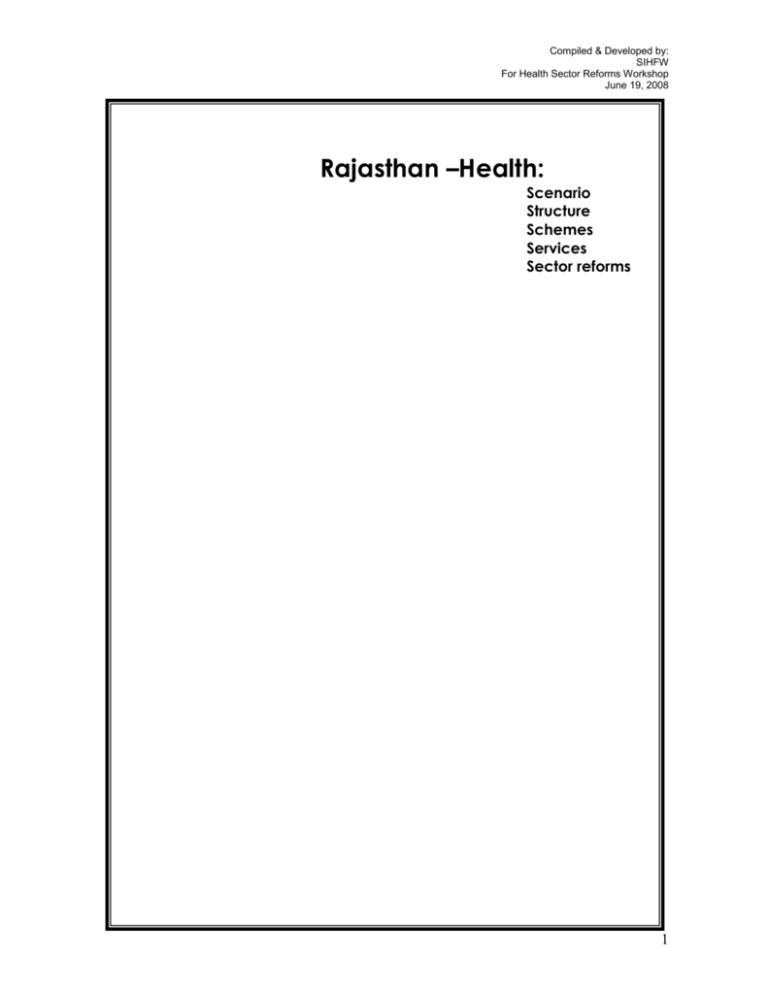
Compiled & Developed by: SIHFW For Health Sector Reforms Workshop June 19, 2008 Rajasthan –Health: Scenario Structure Schemes Services Sector reforms 1 Compiled & Developed by: SIHFW For Health Sector Reforms Workshop June 19, 2008 Background Rajasthan: Location: The largest Indian State Northwest India, Land locked: Punjab in the north, Haryana and Uttar Pradesh in the northeast, Madhya Pradesh in the east and Gujarat in the South. Neighboring country -Pakistan Area: 342240 sq. km 10.41% (of the total country area) Terrain: Desert Plain Hilly Tribal: 5.85 % (of total state area) Population 56, 473, 12 (2001) Divisions: 07 Districts: 33 Municipalities: 183 P. Samitis : 237 Panchayats 9188 Villages : 39793 II. Demographic Profile and Key Health Indicator: India and Rajasthan Sources: Indicators Rajasthan Population (2001) in million$ 56.51 Projected Population (2008) in million@ 66.41 Decadal population growth rate, 1991-2001 28.41 Sex ratio (females per thousand male) 921 Per cent urban 23.39 Literacy rate total 60.4 Literacy rate male 75.70 Literacy rate female 43.9 Per cent Scheduled Cast 17.15 Per cent Scheduled Tribe 12.56 Total fertility rate * 3.2 Crude birth rate ** (CBR) 28.6 Crude death rate ** (CDR) 7.0 Infant mortality rate ** (IMR) 68 Maternal Mortality Rate** 445 Population per sub center 4557 Population per PHC 32193 Population per CHC 147394 Doctors population Ratio 1:9657# $ Census of India 2001, # Based on total population of 2001 * NFHS-III 2005-2006 * *SRS-2005 @ Projected population (March 2008 Census of India). India 1028.61 114.76 21.34 933 27.8 64.8 75.3 53.7 16.2 8.2 2.7 23.8 7.6 58 301 - 2 Compiled & Developed by: SIHFW For Health Sector Reforms Workshop June 19, 2008 Key Indicators for Rajasthan from NFHS-3 (2005-2006) Key Indicators for Rajasthan Women age 20-24 married by age 18 (%) Men age 25-29 married by age 21 (%) Total fertility rate (children per woman) Women age 15-19 who were already mothers or pregnant at the time of the survey (%) Median age at first birth for women age 25-49 Married women with 2 living children wanting no more children (%) Any method (%) Any modern method (%) Female sterilization (%) Male sterilization (%) IUD (%) Pill (%) Condom (%) Total unmet need (%) For spacing (%) For limiting (%) Mothers who had at least 3 antenatal care visits for their last birth (%) Mothers who consumed IFA for 90 days or more when they were pregnant with their last child (%) Births assisted by a doctor/nurse/LHV/ANM/other health personnel (%) 1 Institutional births (%) Mothers who received PNCcare from health personnel within 2 days of delivery for their last birth (%) Children 12-23 months fully immunized (BCG, measles, and 3 doses each of polio/DPT) (%) Children 12-23 months who have received BCG (%) Children 12-23 months who have received 3 doses of polio vaccine (%) Children 12-23 months who have received 3 doses of DPT vaccine (%) Children 12-23 months who have received measles vaccine (%) Children age 12-35 months who received a vitamin A dose in last 6 months (%) Children with diarrhoea in the last 2 weeks taken to a health facility (%) Children with acute respiratory infection or fever in the last 2 weeks taken to a health facility (%) Children under 3 years breastfed within one hour of birth (%) Children under 3 years who are underweight (%) Women whose Body Mass Index is below normal (%) Men whose Body Mass Index is below normal (%) Women who are overweight or obese (%) Men who are overweight or obese (%) Children age 6-35 months who are anaemic (%) Ever-married women age 15-49 who are anaemic (%) Pregnant women age 15-49 who are anaemic (%) Women who have heard of AIDS (%) Men who have heard of AIDS (%) Women who know that consistent condom use can reduce the chances of getting HIV/AIDS (%) Men who know that consistent condom use can reduce the chances of getting HIV/AIDS (%) Currently married women who usually participate in household decisions (%) Ever-married women who have ever experienced spousal violence (%) 57.1 56.7 3.21 16.0 19.6 72.8 47.2 44.4 34.2 0.8 1.6 2.0 5.8 14.7 7.3 7.4 41.2 12.8 43.2 32.2 28.9 26.5 68.5 65.2 38.7 42.7 13.2 56.6 68.9 13.3 44.0 33.6 33.8 10.2 8.4 79.6 53.1 61.2 33.8 74.2 27.3 63.2 40.2 46.3 3 Compiled & Developed by: SIHFW For Health Sector Reforms Workshop June 19, 2008 Health Infrastructure Health Facilities SN 1 2 3 4 5 6 7 8 9 10 11 12 13 14 15 16 17 18 19 20 21 22 23 24 25 26 27 28 29 30 31 32 33 State/Zone Rajasthan Ajmer Bharatpur Jaipur Bikaner Jodhpur Udaipur Kota District Ajmer Tonk Bhilwada Nagaur Bharatpur S.Madhopur Karauli Dholpur Jaipur Dausa Sikar Jhunjhunu Alwar Bikaner Churu Hanumangarh Sri Ganga Nagar Jodhpur Pali Jalore Sirohi Barmer Jaisalmer Udaipur Dungarpur Banswada Chittorgar/Partapgarh Rajsamand Kota Baran Jhalawad Bundi DH/SubDistrict Hospital 126 9 3 3 5 4 3 1 1 19 1 1 3 4 7 5 2 1 13 3 2 2 3 2 9 3 2 3 2 5 1 2 2 126 Types of Facilities CHC PHC 349 11 7 15 17 12 4 5 6 18 7 16 13 21 9 10 8 11 14 15 8 6 14 5 19 7 12 14 7 9 9 14 6 349 1503 43 45 64 88 56 22 27 21 89 29 67 70 73 41 55 39 39 66 65 50 22 58 15 73 38 46 54 35 27 35 28 25 1503 Sub Centers 10512 285 248 392 605 365 197 226 160 505 234 494 323 463 298 353 277 350 498 418 357 187 465 137 551 305 338 394 208 162 210 232 175 10512 The 10th Plan approach focussed on Health sector reforms in areas like efficient & effective public health care, improved organization & Management, Effective implementation of Health programs, Quality Medical education and Promotion of participation by private sector; wherein Strengthening of Infrastructure, Creation of new Infrastructure and strengthening managerial capacity were the main activities. The Department could develop a reasonable Health care delivery infrastructure despite some regional imbalances and a positive change was observed during the plan period in indicators like Crude Birth Rate (28.6,NFHS-III) Crude Death Rate (7.0, SRS-2004), IMR (67, SRS-2004),MMR 4 Compiled & Developed by: SIHFW For Health Sector Reforms Workshop June 19, 2008 (445, SRS-2004), CPR (45.8, 2006, GoR), and TFR (3.2,NFHS IIII).Further, despite a little convergence observed particularly during 2005-06 and 2006-07; the disease specific programs have made substantial change in the Burden of Diseases in Rajasthan. Much still remains to be done to bring the health of State in the mainstream of National averages. Guided by issues of Equity, Gender imbalances, Access and availability, Quality, Decentralization, Institutional strengthening and capacity development, the State has identified its Goals in consonance with National Health Policy, Millennium Development Goals and the basic strategy of NRHM; taking full cognizance of the strengths and weaknesses of the system while capitalizing the opportunities in its way. The State in the last few years have shown progress in terms of health status and outcomes , but the major health indicators are still below the National average . Health Administrative Setup: The organization structure Principal Health Secretary Secretary FW and MD NRHM Director Public Health Director IEC Director F W Director SIHFW Director AIDS Additional Director- State level Joint Director State Level State PMU Divisional Level District Level PMO District PMU CMHO Deputy/Additional CMHO RCHO Block PMU Medical Officer 5 Compiled & Developed by: SIHFW For Health Sector Reforms Workshop June 19, 2008 Medical Education in the State SN Medical College Management Approved intake SMS Medical College, Jaipur SP Medical College, Bikaner RNT Medical College, Udaipur Dr. SN Medical College, Jodhpur JLN Medical College, Ajmer Govt Medical College, Kota Mahatma Gandhi National Institute of Medical Sciences, Jaipur National Institute of Medical Sciences, Jaipur Jhalwad Medical College Govt. Govt. Govt. Govt. Govt. Govt. Private 150 100 100 100 100 100 100 Private Public-Private partnership Govt. Private Private Private 100 100 Private Private 100 50 Private 100 Private 60 Private 100 Private Private 50 100 Dental Wing, SMS Medical College & Darshan Dental College & Hospital, Jaipur Dental College & Hospital, Pacific Dental College Surendra Dental College & Research Institute, Jodhpur Dental College & General Hospital, Jodhpur. Rajasthan Dental College & Hospital, Bagru Khurd, Jaipur. College of Dentistry,Mahatama Gandhi National Institute of Medical Sciences, Jaipur. Ekalavya Dental College & Hosp., Koputli, Jaipur (Rajasthan) NIMS Dental College, Jaipur Vyas Dental College & Hospital, Jodhpur 40 100 100 100 Since the Department has already subscribed to the concept of Public Private Partnership, wherein the private sector will be pursued to invest in capital intensive, state of art diagnostic equipments and Medical education; the plan outlay of the Medical Education shall be substantially reduced. In the ISM sector also, the proposed integration of ISM with official health care delivery system will reduce the cost on account of construction and mobile ISM units, substantially, as they will be using present and infrastructure to be created by medical and health department The issues that punctuates the sanguinity of the present approach is a meagre number of specialists available to man the Community Health Centres and the incompatible output of specialists that the 9 ( one in pipe line) Government Medical schools annually churn out needs immediate remedial measures will have to be taken up by increasing the number of Post Graduate seats For the first time the planning exercise takes into consideration the population, the State will have at the end of Plan (2012), so that the manpower and institutional strength match IPHS standards and Population based norms respectively. This obviously yet aptly inflates the budgetary requirement. Learning from the gaps and reasons thereof, the Department of Health & Family Welfare in Govt. of Rajasthan, has done a vigorous SWOT analysis to draft a relatively prudent & pragmatic plan for future 5 years so as to contribute effectively to national developmental goals besides putting Rajasthan on a relatively higher pedestal in terms of National Indicators at the end of 11 th Five Year Plan period 6 Compiled & Developed by: SIHFW For Health Sector Reforms Workshop June 19, 2008 Human Resources S. No. Title Number Title Numbers 1 2 3 4 5 6 7 8 9 10 11 12 13 14 15 16 17 18 19 20 21 22 23 24 25 26 27 28 29 30 31 32 33 34 35 36 BDS DA DCH DFM DGO DIHBT DM (NEURO) DM (ONCO) DMRD DNB DPH DPM DTCD ENTOMO MBBS MCH MD (ANAE) MD (FM) MD (Med.) MD (Micro) MD (Paed.) MD (Path.) MD (PSM) MD (PSY) MD (Radio) MD(REHAB) MD (Skin) MD (TB) MDS MS (ENT) MS (Gynae.) MS (Ortho.) MS (Ortho) MS (Surgery) TA Vacant Posts 106 17 49 14 35 9 1 1 7 1 8 2 9 1 3615 5 123 3 483 5 252 43 31 26 50 5 19 71 1 93 325 127 134 415 18 1560 Total 7664 Additional Directors Additional Supt. Assistant Director Assistant Professor Clinical Psychologist Coordinator Dietician Director Dy. CM&HO Dy. Directors Dy. Supt. Entomologist JS JSC Joint directors Lecturer Medical Officers Medical Officers (DENT) MOC Neuro Surgery PG PH Lec. SMO SMO (DENT) Senior (Demo) Senior (LEC) SS STO APO Deputation Extra Higher Education Lama Long Leave Others (Not Joined, Resign, Suspend No filled Absent Total 8 2 2 5 8 1 1 4 52 93 1 1 1762 18 21 1 3662 105 62 1 197 1 800 13 6 1 273 1 27 39 81 1 5 1 135 176 97 7664 The guiding principles for the State Health care delivery are: Equity – Poverty Focused Gender Sensitive Access and availability Quality Convergence Development focused Decentralization 7 Compiled & Developed by: SIHFW For Health Sector Reforms Workshop June 19, 2008 Institutional strengthening and capacity development Public Private partnership Community Partnership/ Involvement At the State level a thorough analysis of the potential and punctuations has been done SWOT analysis (in context of National Health Policy-2002): 1. Strengths: a. b. c. d. e. f. Policy promoting Private investment State Population Policy Commitment Infrastructure created under different Schemes and Projects Planning cell in DMHS Financial inputs (surplus in different schemes/ Projects, inappropriate Utilization) g. Private sector in Medical Education h. University of Health Sciences i. Training Policy j. RMRS(User charges, Life line fluid stores) k. Essential Drug List (though needs revision). 2. Weaknesses: a. Planning ( Ad hoc, evidence base missing, Need to develop “ Information Culture”, resurrect & sustain area-specific Micro-planning efforts that were once initiated in 1994-95, No strategic State plan-Planning cell functions limited to targets and budget allocations) b. Vertical implementation, Duplication of efforts (Donor Pressure & Priorities), Lack of Integration c. Implementational competence for capacity & juggling priorities d. Training (Repetitive, content, class room based, Profile of trainees-Age, no feed back) (To be made Centralized at identified institution with identified core group of minimum 10 Trainers- exclusive to the job) SIHFW to take the lead e. HMIS (fragmented, survey based secondary data, ad hoc approach, out of “compliance”, for print v / s in planning use of data, Technology) f. Mobile Camp approach/ Door step delivery ( has increased dependence and resulted in poor utilization leading to increase cost; reconsider) g. Urban bias of Medical education & Training h. Limited intake capacity of Medical Schools i. Lack of accreditation system j. No regulation for Clinical Establishments (Clinical establishment regulationAct?) k. Urban Health care l. Majority of Projects & Schemes, by and large, restricted to 7-8 Districts m. Location of Health Facility (impact on utilization?) n. Health Policy o. HRD Policy (Managerial capability, Future projections? Job enrichment?) 8 Compiled & Developed by: SIHFW For Health Sector Reforms Workshop June 19, 2008 3. Opportunity: a. b. c. d. e. 4. NRHM (Funding & Commitment) RSHSDP Integration of ISM Expression of intent by corporate Hospitals to come to State Tele-Medicine project Threats: a. b. c. d. e. Program specific Societies to implement under donor pressure Changing Morbidity Profile Manpower shortage (Nurses & Paramedical) Frequent changes in position of trained manpower Increasing cost of Drugs (Generic prescriptions and a prudent essential drug list can help) f. Un-utilized funds, next kitty might get reduced (Financial Planning, System of Accountability) g. Contract employment (v / s Service based payment system) h. Non-existent Disaster/ Epidemic management plan i. Wide geographical disparities j. Non implementation of transfer policy Objectives and Priorities: Objectives :To achieve levels indicated in National Health Policy-2002 Priorities :Decide on Indicators and quantify the achievable, in context to National Policy Prioritize indicator(s) where change is to be sought and then identify and dovetail all programs & activities expected to make impact besides, pooling of finances irrespective of source, e.g. i. Indicator : MMR ii. Present situation: 445 (SRS-2004) iii. Goal (say) : 400 by end of 11th Plan (State Pop. policy aims at 285 by 2011) : NRHM aims at 148 by 2012 iv. Programs/ Schemes : a. Major-NRHM, RCH, FW b. Minor: Immunization, ICDS c. Support: RSHSDP v. Identify & club activities related toInfrastructure Logistics Training Service delivery Monitoring vi. Funding : a. State b. Central c. Bilateral agencies vii. Sub areas that will be addressed: a. IMR 9 Compiled & Developed by: SIHFW For Health Sector Reforms Workshop June 19, 2008 b. CPR c. CBR d. CDR 2. 3. 4. 5. 6. 7. 8. 9. 10. 11. State Policy and Planning (Health & Hospital) wing with strong HMIS (Information and Data on health related events & activities, from all levels including Medical Colleges, to be compiled & used in monitoring & planning) Develop discipline of Public Health/ Community Medicine (assign 1/4 of PG seats, NHP-2002) Health Research (allocate 2% of total Health budget, NHP-2002) Strengthen State Epidemiology Cell and create District Epi. Units with trained manpower, adequate infrastructure and finances. i. Capacity building of Service providers and Managers through: Induction Trainings by SIHFW, Incremental planning and financing Capacity building of LSG & PRIs Interface between Health & Environment related programs visible Objectives identifying indicator where change is to be made and quantum of change by end of 11th Plan Medical Education i. Increase Intake ii. Consider NRI seats in Govt. Colleges iii. Health University for uniformity iv. Regulation of Standards in Para Medical courses & Training Develop a strong referral linkage with down referral and feedback Private Public Partnership: Need: 1. Increasing cost of care for people as well as providers 2. Increasing awareness & expectations 3. Limited resources (only 0.9 % of GDP allocated for Health) 4. New emerging diseases, 5. Changing disease profile, 6. Technical and diagnostic advances, 7. Longevity of life(Increasing BOD), 8. Subsidies and cross-subsidies 9. Increasing non-plan expenditure, and 10. Competing priorities 11. Medical/ Health Tourism Steps: 1. Policy (Private Investment promotion policy already pronounced) 2. Enumerate strengths of Private sector (Allopathic & ISM) a. Geographical presence and number b. Specialization c. Advancements (Seek help from Private practitioner’s society or a private agency for enumeration) 3. Work out a mechanism for spare capacity utilization (resource pooling) 4. Out-sourcing by Public Sector, particularly for capital-intensive & Technology based interventions 5. Identify areas & Services where Private sector could be supportive a. Low coverage areas (Empanelment as in NHS (UK) or ESI) particularly with reference to areas where manpower shortage exist e.g. Anesthetists and Gynecologists b. Advance diagnostics 10 Compiled & Developed by: SIHFW For Health Sector Reforms Workshop June 19, 2008 6. 7. 8. 9. 10. c. Advanced interventional procedures d. Implementation of National Health Programs (Require sensitization in context to approach e.g. RNTCP, UIP and involvement). e. Medical/ Dental and Para Medical training schools Referral mechanism for Private sector on predefined terms of payment Accreditation system for promoting Health Tourism Develop norms & Standards for Health care facilities Involve Private sector in planning (nomination, Circulation of Drafts for comments, invitation to planning and Monitoring meetings) Health Insurance (to be offered on payment or purchased on premium?) Beneficiary Specific Programs, Policies & Program design: Basic premise: 1. Trust (System works-Eradicated Small Pox, Guinea worm –a history, Nearing eradication of Polio) 2. Punctuations to Achievements (hitherto and henceforth) i. Vacancies ii. Presence of service providers iii. Frequent Paradigm shifts iv. Utilization 1. Logistics 2. Availability of services & Manpower 3. Competence of providers 4. Camp approaches 5. Past experience 6. location of facility 3. Policy v/s Implementation 4. Sustainability of efforts?, for shift in priorities 5. Monitoring & Feedback 6. NRHM shall be in place till end of 11th Plan withi. Convergence ii. Integration iii. District centered iv. Focus on PRIs & LSG 7. No State Health Policy 8. Presence of Private sector 9. Practitioners of ISM-supplementary not substitutes of Official System Policy Prescription Issues (for the entire plan period): a. Restructuring of Health Care Delivery System b. District to be basic Planning & Executing agency i. Area specific, evidence driven, priority based Micro planning ii. Convergence ofa. Priorities b. Efforts c. Finances iii. Strengthening of District Health System in terms of Manpower/ Logistics/ Managerial competence/ Job enrichment/Administrative & Financial powers to improve effective implementation iv. Training policy implementation(Duration-lower the level higher be the period) v. Defined job responsibilities (Document already scripted) vi. Placement & Transfers within District a. Seek choice b. Place for 5 years (refer to transfer policy) vii. District planning( Health & Hospital) cell with HMIS and automation 11 Compiled & Developed by: SIHFW For Health Sector Reforms Workshop June 19, 2008 viii. District Epidemiological units, with Rapid Response Teams & Laboratory( with placement of trained manpower &logistics) ix. Monitoring and evaluation instruments and mechanism x. Citizen Charters xi. Service Delivery a. Gen. population i. Freebees ii. Services on Payment b. BPL families i. Enlistment ii. Regulatory Mechanism to address misuse c. State to i. Offer Basic broad guidelines in consonance to State (?) & National Health Policy-2002 ii. Develop Norms & Standards iii. Facilitate Fund flow from Central agencies iv. Monitor quarterly d. NGOs i. Enlistment (probably already in place) ii. Capacity & Experience ( in Health care) iii. Explore possibility of transferring selected Primary care units a. Norms to be followed b. Manpower (Govt.? or by NGO) c. Initial Support? d. Recurring expenses- Reimbursement in part, full or none e. Freedom to levy user charges iv. System of Accountability e. PRIs & LSG to own primary health care in Rural & Urban areas. i. Approacha. Selected PHCs or all PHCs in selected districts ii. Willingness & Competence(?) of PRIs to own & manage primary care iii. Funding Mechanism iv. Authority & Autonomy v. Checks to watch misuse vi. Delivery of care through a System mix (ISM+ Allopathic), availability under one roof vii. Relocation of Institutions (from outer skirts to centre of village- increases utilization) and provision of residential units viii. Cost recovery-User charges? (assures ownership & involvement) ix. Community based Health Insurance (Health Care Cooperatives-Chinese experience?) x. Mechanism for interaction and developing linkages with Secondary/ Tertiary care xi. Manpowera. from State pool, minimum 3 years, or b. On contract, service based payments 12 Compiled & Developed by: SIHFW For Health Sector Reforms Workshop June 19, 2008 Health Sector Programmes National Rural Health Mission/ Reproductive and Child Health Phase- II The National Rural Health Mission (2005-12) seeks to provide effective healthcare to rural population throughout the country with special focus on 18 states, which have weak public health indicators and/or weak infrastructure. RCH-II is a major programme that comes under the umbrella of the NRHM .The overall goal of RCH Programme is to reduce infant and maternal morbidity and mortality as well as total fertility rate in the state. These goals will be achieved through improvement in quality, enhancing accessibility and availability and coverage of the reproductive and child health services, including family welfare services. The Programme will emphasize empowerment of women and communities for enhancing health service utilization to achieve reproductive health goals and population stabilization. The Programme goals are stated below: Indicators Total Fertility Rate Birth Rate Death Rate Infant Mortality Rate MMR Source:* NFHS-III 2005-2006 **** Goals set as per XI Plan document 2007 3.21* 28.6** 7.0** 68.0** 445*** **SRS-2005, ***SRS- 2003, 2012**** 2.1 21.0 7.0 32 148 Some of the initiatives under the NRHM/RCH-II programme ASHA- Sahayogini: In order to increase utilization of health facilities and services, under the National Rural Health Mission, a trained village based health worker named ASHA Sahayogini (Accredited Social Health Activist) at every 1000 population will act as a bridge between rural women and children and health services in the State of Rajasthan. However, for tribal and desert districts which have many small villages with population less than 1000, this norm has been relaxed. Till March 2008 a total of 39325 ASHA-Sahyoginis have been selected. In year 2007-2008, selection of remaining ASHAs will be completed. The ASHA Resource Center (ARC) has been established at State level in State Institute of Health and Family Welfare which is providing technical backstopping to the programme. ASHA-Sahyogini Mentoring Group is constituted at State level to provide guidance to ASHA-Sahyogini programme. Untied Funds: To strengthen the Sub center and referral system, each sub center has been given Rs.10000/- as untied fund and joint account of ANM and Sarpanch have been opened. Three trenches of the Untied funds have been disbursed to the Sub centers. Untied funds have been also disbursed to the District Hospital, Community Health Center and Primary health centers. MCHN Days: The Mother and Child Health Nutrition Days are being organized on a particular fixed day once in a month in all 40,000 villages for providing the services related to mother and child, immunization and nutrition. Jan Mangal Couple: To promote the accessibility and awareness on the non clinical contraceptives in the villages, a Jan Mangal Couple has been provided for a population of 1000.They enhance the community based distribution of the contraceptives. First Referral Unit and 24 * 7 PHCS : FRU are being operationalised in the state to provide emergency obstetric care , neonatal care and blood transfusion services . 24x7 PHCs are also developed to provide 24 hrs services to the community. 13 Compiled & Developed by: SIHFW For Health Sector Reforms Workshop June 19, 2008 IMNCI: Integrated Management of Neonatal and Childhood Illness (IMNCI) is implemented in all the districts of Rajasthan. This is an integrated and effective approach for managing neonatal and childhood illness. Life Skills Education: In collaboration with the Education Department, the Life skills education has been incorporated as a separate subject in the curriculum of the 11 th Class. 3.5 lakh children are being covered under this initiative. Malnutrition corners: To address the malnutrition among the children, malnutrition corners have been operationalised in the District hospital to provide the complete range of services for addressing the malnutrition. A glance at the achievement of the RCH –II programme under the Family Planning, Maternal Health and Child Health for the year 2007-08 S.No. Particulars ELA % Achievement % Increase/ Decrease from last year 73.21 16.29 99.16 114.57 119.43 98.43 11.41 8.55 6.86 3.97 982837 47.96 13.29 1337321 65.25 18.89 Achievement 12555 322474 335029 337979 635541 744866 2017195 8 Male Sterilization Female Sterilization 457655 Total Sterilization IUD Insertions 340827 OP Users (New) 554705 CC Users (New) 623690 ANC Registration 2049383 ANC Registration with in 12 2049383 weeks ANC Registration who have 2049383 received 3 check-up TT (PW) 2049383 1915998 93.49 4.19 9 Institutional Deliveries 1844445 1018842 55.24 40.97 10 11 JSY Beneficiaries Full Immunization 1738250 774877 1615685 92.95 2.72 1 2 3 4 5 6 7 NRHM and RCH Components: Progress SN 1 2 3 4 Activities District Health Society Meeting ASHA Sahyogini Selection Untied fund Account ( Sub Centers IPHS Expected accomplishment 384 42136 10742 128 (CHCs) 5 6 7 8 9 10 11 12 13 14 AYUSH Integration Dai Training RCH Camp Additional ANM Selection Functional BEmOC PHN selection LT selection RMRS Registration IMNCI RMRS Registration (PHCs) 657 6000 1920 1321 176 158 158 1907 180 1503 Achievement 236 39325 10498 Facility Survey done ;116 Civil Work /Training done in 85 632 2647 1682 943 130 133 135 1911 168 1503 14 Compiled & Developed by: SIHFW For Health Sector Reforms Workshop June 19, 2008 Intersectoral Convergence in NRHM To achieve the goals and objectives of NRHM ensuring the intersectoral convergence is very critical as the achievement of health is determined by various factors. The role of the different departments like Women and Child , Education , Panchayati Raj, PHED and AYUSH is very critical in achieving the objectives of the RCH-II programme . Convergence in planning and other stages of implementation of program is very important and NRHM has various institutional mechanisms like State health society and District health society to facilitate the same. The various convergent programmes with the different departments and the challenges are detailed below; Convergence with DWCD 1. AWC has become the focal point of health and nutrition services. Role of ASHA has been given to Sahyogini’s of DWCD so that greater convergence can be achieved. Integration in training and BCC is need to be emphasized. 2. MCHN day is observed on each AWC where all the activities of health, nutrition and NRHM being observed. Monitoring of MCHN days is an important issue. Supervisory visits of MO in MCHN days can make the difference in the quality of services. Lack of supervisory staff especially in Rajasthan is a big challenge to ensure the quality MCHN days. 3. Joint planning at each level, common BCC strategy at state and district level, joint training and joint M&E are some of the areas of convergence with DWCD which can be explored. Convergence with PRIs 1. Panchayats have been assigned 29 rural development activities, out of them several are related to health and population stabilization. Provision of strengthening of VHSCs under NRHM is one of the critical areas of convergence. Under NRHM provision of untied fund of Rs.10000 to each VHSC is a step to involve the panchayats in health activity. There is a need to sensitize the members of the VHSC about village health plan and its implementation. 2. Preparation of village health plan and its implementation is one of the opportunity to panchayats for taking ownership in matters of health is their area. 3. Particular emphasis & interventions for PRI relate to registration of births, marriages and deaths enabling death audits, ensuring transport for emergencies, ensuring legal provisions regarding age at marriage and finally ensuring that services are in consonance with needs. 4. In health sector, devolution of powers to PRIs is an issue. In some of the sectors devolution of powers is still awaited. Transfer of funds, its judicious utilization and priority to addressing the need of vulnerable groups is some of the issue need to be addressed in our state. 5. The role of Panchayats in the area planning, community monitoring, supervision of services and registration of birth , deaths should be strengthened. Convergence with NACP Convergence at program level in NACP is still awaited. Number of activities in NACP and RCH-II are common. To reduce duplication in fund disbursement and supplies and drugs ,common planning, common M&E and joint training and BCC mechanism need to be evolved. Areas of convergence are : 1. 2. 3. 4. 5. RTI/STI management Condom promotion by ASHA VCTC and PPTCT services to HRC through ASHA BCC/Training Mother NGO and TI-NGO Schemes 15 Compiled & Developed by: SIHFW For Health Sector Reforms Workshop June 19, 2008 AYUSH Integration An effort is being made to integrate AYUSH System in Health Care Delivery System under National Rural Health Mission. For mainstreaming of AYUSH in NRHM, the personnel of AYUSH shall work under one roof and separate space would be allocated exclusively for them in the same building. In case, separate space is not available at the PHCs/CHCs civil works will be undertaken from the funds provided to Ayush Department for this purpose. AYUSH Practitioners are appointed on contractual basis so that AYUSH becomes a part of Primary Health Care and AYUSH medicine will be dispensed through them. Convergence with PHED Swajaldhara, TSC and NRHM rely on community lead approaches. As TSC and Swajaldhara does not have any field functionaries to motivate the people but ASHA can take the responsibility for the job. Role of ASHA is in Swajaldhara and TSC is yet to be evolved. Challenges 1. The key to the successful implementation of NRHM are inter-sectoral convergence, community ownership steered through Village Health & Sanitation Committees at the level of the Gram Panchayat and a strong public sector health system with the support from the private sector. 2. The success of convergent action would depend on the quality of the district planning process. In the state process of preparation of District Health Action Plans has been initiated long back but still districts are abandoned with comprehensive plan. Those who have plan need to revisit yearly to ensure the component of convergence with different determents. Reflection of integration of different components including – drinking water, sanitation, women’s empowerment, adolescent health, education, female literacy, early child development, nutrition, gender and social equality in plans is not sufficient it self Need is to see the reflection in implementation of activities. After 3 years of NRHM launch there is hardly few cases of convergence seen with TSC program or Swajadhara program. Placement of AYUSH doctors at PHC is not the answer of convergence need is promoting the services of AYUSH as well as utilization of expertise of AYUS in National health program 4. To promote women’s empowerment, gender and equity, great opportunity is available to use the services of SHG network. There are more than 35000 SHGs in the State. Through issue based and target oriented BCC SHGs can be activated for promoting the MCHN & women empowerment services. PPP under NRHM in Rajasthan The National Rural Health Mission (NRHM) aims at providing comprehensive integrated healthcare to the rural people especially the vulnerable sections of the society, the women and the children. The Mission recognizes that health status of families is influenced by variety of factors such as availability of safe drinking water, sanitation, nutrition, social environment etc. Social, cultural and economic factors play an important role in health status of the individual, family and community. For achieving the objectives of the Mission and considering gigantic tasks, it is extremely important to seek support from various private and public partners. There is a great scope of involving non government bodies, like NGOs, Private Hospitals, Nursing Homes, Private Practitioners, Prominent Donors most importantly Business Houses who are genuinely concerned about health related issues, have managerial and financial capabilities and wants to make a positive change in the existing health scenario. A Public Private Partnership Cell has been set up within the department of medical and health under RHSDP. The roles and responsibility of the cell will be to identify the areas for partnership, 16 Compiled & Developed by: SIHFW For Health Sector Reforms Workshop June 19, 2008 prepare comprehensive policy for PPP in health sector, maintain database of all private agencies, capacity building, monitoring, evaluation and various studies related to PPP initiatives etc. Urban RCH Centers in Slum Areas The Government of Rajasthan has initiated the Urban RCH programme in partnership of NGO/ Hospital/ Private Health Institutions for managing RCH center in identified slum areas for the cities Ajmer, Alwar, Bikaner, Bharatpur, Jodhpur, Kota and Udaipur on pilot basis. The pilot phase would be of one year. The NGO/ Hospital/ Private Health Institutions will ensure the availability of the following: - Health center in the identified slum area, Staff as per guideline for health center and Aid post ,Equipment, Instruments and furniture as per norms ,Delivery of service as per the project. The Department will provide all the wages for the staff, appointed by the NGO, recurring cost of the center along with the amount for medicines equipment and furniture, on quarterly basis after submission of reports. The Department would also provide drugs, supplies and consumables as per the provision of budget. In addition to this, an administrative cost would be the NGO to mange its office at district level, for supervision of I Tier Center. Development of District Health Plans - Six technical resource agencies were selected for preparation of District Action Plans for 32 Districts. At State level, one agency was selected to compile and collate the palns received from district level. These agencies have developed the District Action Plans with support and involvement of stakeholders like CMHOs, RCHOs, DPMs, PMOs, etc apart from representatives of different department's like- DWCD, PHED, Education. NGOs and CBOs are also involved in the process of development of District Action Plans. MNGO Scheme - To create awareness of RCH services in inaccessible areas MNGO scheme is implemented in the State. At district level, Mother NGOs are selected. These MNGOs develop an action plan for inaccessible Villages. The awareness campaigns are implemented through field NGOs which are identified by MNGO. At present this scheme is functional in 24 Districts and selection in rest of the districts is in process. Medical Mobile Units (MMU) - With the objective of provision of health care services at doorstep in the rural areas, especially in under served areas, 52 Medical Mobile Units are developed. Each Unit consist of 2 vehicles- one for the movement of doctors and paramedical staff and other is for services. These units will provide medical facilities in the difficulty hilly and desert terrain, which are normally not approachable by public transport. The partnership is made with an NGOs in operationalization of MMUs. NRHM will provide the vehicles with drugs and equipments and NGOs will arrange for the manpower. These units will be handed over to the NGOs for provision of Services. Apart from NGOs, private medical collages and hospitals are also the partners in the scheme. Trainings - NGOs and Private hospitals are involved in technical trainings. The training of trainers on blood storage units are conducted in the private hospital. Training of skilled birth attendant is carried out by an NGO who has a wide experience of utilizing ANM in provision of obstetric services at grass root level. Blindness Control- The partnership is made with an NGOs and philanthropic organizations for provision of services of eyes checkups, cataract operations etc. In this partnership organizations are involved in awareness generation and logistics arrangements. The services of ophthalmologist, technical team is mostly provided by the public health Institutions. In the State, eighty percent of cases of cataract operations are conducted in the camps organized by NGOs. Involvement in provision of FP services - The private sector institutions are providing quality health care services to the society. The private institutions are accredited for provision of family planning services on the set criteria like infrastructure, qualified service providers, technical team, equipments and drugs etc. The accredited institutions are providing family planning services like male and female sterilization, IUD insertions, provision of non clinical contraceptives etc. Health 17 Compiled & Developed by: SIHFW For Health Sector Reforms Workshop June 19, 2008 Department is providing supplies of contraceptives, required stationary, and some monitory support to the accredited institutions. The sterilization incentives are also provided to the institutions for further distribution to the clients who have undergone sterilizations. Accreditation under Janani Suraksha Yojana - There is provision of Accreditation of minimum two private institutions for providing delivery services in each block. The process of Accreditation is initiated in the state and IMA /FOGSI is actively involved. The benefits of the scheme are provided to the mothers availing services of these institutions. Hiring of Services of Doctors - There is a shortage of specialists like anaesthetists, gynaecologists, in the public health system. The areas are identified and the services of services of specialists, who are working in private sectors, are hired at district level as per the specific tasks and requirements like sterilization camps, conducting operative delivery. The services of gynaecologist, anaesthetists are also hired if not available in the institution. Hiring of Additional ANM, PHN and Lab Technicians - The services of ANM, PHN and Lab Technicians are being hired through Non Governmental Organizations and private service agencies at district level. ASHA Sahyogini trainings-There is a crucial role of NGOs in training of ASHA Sahyogini. The training is being conducted through selected NGOs at block level. NGOs are involved in logistics arrangements of the trainings. The NGOs are selected at district level by the committee constituted under the Chairpersonship of District Collector. Community monitoring in RCH-II/NRHM - External monitoring and evaluation of health services is very essential to improve the quality and acceptability of services. Family Counseling Centers (FCC) - To address the gender based violence from public health perspective, family counseling centers are established at 8 districts. The FCCs were established with the objective to provide medical care and professional counseling services to the victims of violence. NGOs are involved in operationalization of FCCs. 18 Compiled & Developed by: SIHFW For Health Sector Reforms Workshop June 19, 2008 Health Sector Reforms in Rajasthan The Main aim of Health Sector Reforms is Defining priorities Refining policies Reforming Institution HSR Deals with equity, efficiency, quality and financing In principles, Health Sector Reforms address to ooverseeing the needs of the entire population gender sensitive and client friendly, looking forward to the health transition, removing the blind spot to the private sector, focusing efforts for ensuring quality, efficiency and accountability of health services The key elements of Health Sector Reforms are, structural rather than incremental/evolutionary change, change in policy objectives followed by institutional change, rather than redefinition of objectives alone, purposive rather than haphazard change ,sustained and long term rather than one off change, political top down process led by national, regional or local government. HSR initiatives in Rajasthan Jan Mangal Project 1992 Strengthening FRU’s 1994-2001 Decentralized District Planning since 1995-96 Cost recovery mechanism-RMRS-user charges since 1995-96 Reorganizing the Training System 1995-96 Concurrent Evaluation in F.W.Program 1996-97 Promoting private sector in Medical ,Dental & Nursing Education Draft Training Policy 1997-98 Devolution of Powers to PRI’s - 90’s Population Policy 2000 Job Responsibilities specifications 2000 Preparation of Essential Drug List 1997 ( 2000 revised) Health Vision Document 2025 Policy to “Promote Private sector Investment in Health Cara facilities-2006” “Policy to promote private sector in Health care facilities-2006”\ BPL cards to families for increasing service reach,1997 Contracting out of Capital intensive radio-imaging diagnostics in tertiary care. Health Insurance for BPL families Abhilasha Yojana (Preparing women from Self Help Groups for Geriatric care),2007 Patanjali Yojana ( Addressing Non-Communicable diseases,2007 Policy for contracting out PHC/ CHC to private sector,2008 Emergency Management and Research Institute under PPP initiative, 2008 19
